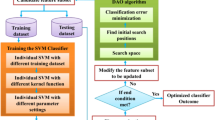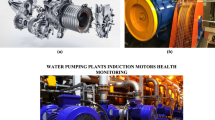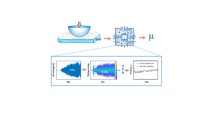Abstract
Several parameters of industrial processes are indirectly measured by multi-scale mechanical frequency spectrum. Selecting suitable mechanical sub-signals and relevant frequency spectral features for different process parameters remains an open issue. This study proposes a new optimized ensemble model based on feature selection using simple sphere criterion (SSC). Mechanical signals are adaptively decomposed and transformed into frequency spectral data with different timescales. These spectral data are fed into adaptive multi-scale spectral feature selection and modeling framework, in which local-scale frequency spectral features are adaptively selected with concurrent projection to latent structures and SSC based on unscaled data. The optimized ensemble model is constructed with selective information fusion strategy based on reduced frequency spectral data. The feature selection and model learning parameters are jointly selected. Simulation results based on the mechanical vibration and acoustic signals of an experimental laboratory-scale ball mill show the effectiveness of the proposed scheme.







Similar content being viewed by others
References
Chai TY, Ding JL, Wu FH (2011) Hybrid intelligent control for optimal operation of shaft furnace roasting process. Control Eng Pract 19(3):264–275
Chai TY, Ding JL, Yu G, Wang H (2014a) Integrated optimization for the automation systems of mineral processing. IEEE Trans Autom Sci Eng 11(4):965–982
Chai TY, Qin SJ, Wang H (2014b) Optimal operational control for complex industrial processes. Annu Rev Control 38(1):81–92
Cusido J, Romeral L, Ortega JA, Rosero JA, Garcia-Espinosa A (2008) Fault detection in induction machines using power spectral density in wavelet decomposition. IEEE Trans Ind Electron 55:633–643
Dai W, Zhou P, Zhao D, Chai T (2016) Hardware-in-the-loop simulation platform for supervisory control of mineral grinding process. Powder Technol 288:422–434
Das SP, Das DP, Behera SK, Mishra BK (2011) Interpretation of mill vibration signal via wireless sensing. Miner Eng 24:245–251
Feng TJ, Wang HG, Xu WL, Xu N (2012) An on-line mill load monitoring system based on shell vibration signals. Min Metall 19:66–69
Hao RH, Yang ZF, Wen XX (2009) An efficient gene selection algorithm based on mutual information. Neurocomputing 72(4–6):991–999
Huang NE, Shen Z, Long SR (1998) The empirical mode decomposition and the Hilbert spectrum for non-linear and non stationary time series analysis. Proc R Soc Lond A 454:903–995
Huang P, Jia MP, Zhong BL (2009) Investigation on measuring the fill level of an industrial ball mill based on the vibration characteristics of the mill shell. Miner Eng 14:1200–1208
Kadlec P, Gabrys B, Strandt S (2009) Data-driven soft sensors in the process industry. Comput Chem Eng 33(4):795–814
Kano M, Fujiwara K (2013) Virtual sensing technology in process industries: trends & challenges revealed by recent industrial applications. J Chem Eng Jpn 46(1):1–17
Leardi R, Seasholtz MB, Pell RJ (2002) Variable selection for multivariate calibration using a genetic algorithm: prediction of additive concentrations in polymer films from Fourier transform-infrared spectral data. Anal Chim Acta 461(2):189–200
Lei YG, He ZJ, Zi YY (2009) Application of the EEMD method to rotor fault diagnosis of rotating machinery. Mech Syst Signal Process 23:1327–1338
Liu H, Sun J, Liu L, Zhang H (2009) Feature selection with dynamic mutual information. Pattern Recogn 42(7):1330–1339
Lo YC, Oblad AE, Herbst JA (1996) Cost reduction in grinding plants through process optimization and control. Miner Metall Process 8:19–21
Qin SJ (2012) Survey on data-driven industrial process monitoring and diagnosis. Annu Rev Control 36(2):220–234
Qin SJ, Zheng YY (2013) Quality-relevant and process-relevant fault monitoring with concurrent projection to latent structures. AIChE J 59(2):496–504
Rai VK, Mohanty AR (2007) Bearing fault diagnosis using FFT of intrinsic mode functions in Hilbert–Huang transform. Mech Syst Signal Process 21:2607–2615
Riera-Guasp M, Antonino-Daviu JA, Pineda-Sanchez M, Puche-Panadero R, Perez-Cruz J (2008) A general approach for the transient detection of slip-dependent fault components based on the discrete wavelet transform. IEEE Trans Ind Electron 55:4167–4180
Rosipal R, Trejo LJ (2002) Kernel partial least squares regression in reproducing kernel Hilbert space. J Mach Learn Res 2:97–123
Seshadrinath J, Singh B, Panigrahi BK (2014) Vibration analysis based interturn fault diagnosis in induction machines. Trans Ind Inf 10:340–350
Tang J, Chai TY (2013) On-line KPLS algorithm with application to ensemble modeling parameters of mill load. Acta Autom Sin 39(5):471–486
Tang J, Zhao LJ, Zhou JW, Yue H, Chai TY (2010) Experimental analysis of wet mill load based on vibration signals of laboratory-scale ball mill shell. Miner Eng 23(9):720–730
Tang J, Zhao LJ, Yue H, Yu W, Chai TY (2011) Vibration analysis based on empirical mode decomposition and partial least squares. Proc Eng 16:646–652
Tang J, Chai TY, Zhao LJ, Yu W, Yue H (2012a) Soft sensor for parameters of mill load based on multi-spectral segments PLS sub-models and on-line adaptive weighted fusion algorithm. Neurocomputing 78:38–47
Tang J, Chai T, Yu W, Zhao LJ (2012b) Feature extraction and selection based on vibration spectrum with application to estimating the load parameters of ball mill in grinding process. Control Eng Pract 20:991–1004
Tang J, Chai T, Yu W, Zhao L (2013) Modeling load parameters of ball mill in grinding process based on selective ensemble multisensor information. IEEE Trans Autom Sci Eng 10(3):726–740
Tang J, Chai TY, Cong QM, Zhuo L, Wen Y (2015) Modeling mill load parameters based on selective fusion of multi-scale shell vibration frequency spectra. Control Theory Appl 32(12):1582–1591
Tang J, Yu W, Chai TY, Liu Z, Zhou XJ (2016a) Selective ensemble modeling load parameters of ball mill based on multi-scale frequency spectral features and sphere criterion. Mech Syst Signal Process 66–67:485–504
Tang J, Chai TY, Yu W, Liu Z, Zhou XJ (2016b) A comparative study that measures ball mill load parameters through different single-scale and multi-scale frequency spectra-based approaches. IEEE Trans Ind Inf 12:2008–2019
Tang J, Liu Z, Chai T, Chai T, Chai T, Yu W (2016c) Kernel latent features adaptive extraction and selection method for multi-component non-stationary signal of industrial mechanical device. Neurocomputing 216:296–309
Tang J, Qiao J, Wu ZW, Chai T, Zhang J, Yu W (2018) Vibration and acoustic frequency spectra for industrial process modeling using selective fusion multi-condition samples and multi-source features. Mech Syst Signal Process 99:142–168
Wang W, Chai T, Yu W (2012) Modeling component concentrations of sodium aluminate solution via Hammerstein recurrent neural networks. IEEE Trans Control Syst Technol 20(4):971–982
Wu Z, Huang NE (2009) Ensemble empirical mode decomposition: a noise-assisted data analysis method. Adv Adapt Data Anal 1:1–41
Yu G, Chai TY, Luo XC (2011) Multiobjective production planning optimization using hybrid evolutionary algorithms for mineral processing. IEEE Trans Evol Comput 15(4):487–514
Yue H, Qin SJ, Markle RJ, Nauert C, Gatto M (2000) Fault detection of plasma ethchers using optical emission spectra. IEEE Trans Semicond Manuf 11:374–385
Zhou P, Chai T, Wang H (2009) Intelligent optimal-setting control for grinding circuits of mineral processing process. IEEE Trans Autom Sci Eng 6(4):730–743
Acknowledgements
This work is partially supported by the National Natural Science Foundation of China (61573364, 61703089, 61503066, 61503054, 61573249), State Key Laboratory of Synthetical Automation for Process Industries (PAL-N201605), State Key Laboratory of Process Automation in Mining and Metallurgy, and Beijing Key Laboratory of Process Automation in Mining and Metallurgy (BGRIMM-KZSKL-2017-07).
Author information
Authors and Affiliations
Corresponding author
Ethics declarations
Conflict of interest
The authors declare that they have no conflict of interest.
Ethical approval
This article does not contain any studies with human participants or animals performed by any of the authors.
Additional information
Communicated by V. Loia.
Appendices
Appendix A: PLS algorithm
Projection to latent structures or partial least squares (PLS) constructs a linear multivariable regression model with the extracted latent variables (LVs) from the original input/output data space. It projects input data \( \varvec{X} = \{\varvec{x}_{l} \}_{l = 1}^{k} \) and output data \( \varvec{Y} = \{\varvec{y}_{l} \}_{l = 1}^{k} \) to a low-dimensional space defined by a small number of LVs \( (\varvec{t}_{1}, \ldots,\varvec{t}_{h}) \). PLS decomposes the input and output data into the following form:
where \( {\varvec{T}} = \left[{{\varvec{t}}_{1}, \ldots,{\varvec{t}}_{h}} \right] \) and \( {\varvec{U}} = \left[{{\varvec{u}}_{1}, \ldots,{\varvec{u}}_{h}} \right] \) are the latent scores; \( {\varvec{P}} = \left[{{\varvec{p}}_{1}, \ldots,{\varvec{p}}_{h}} \right] \) and \( {\varvec{Q}} = \left[{{\varvec{q}}_{1}, \ldots,{\varvec{q}}_{h}} \right] \) are the loadings for \( {\varvec{X}} \) and \( {\varvec{Y}} \), respectively; and \( {\varvec{E}} \) and \( {\varvec{F}} \) are the residual matrices corresponding to \( {\varvec{X}} \) and \( {\varvec{Y}} \), respectively. The number of LVs \( h \) is usually determined with a cross-validation method. The prediction model based on PLS can be expressed as
However, unlike that with PCA, \( {\varvec{T}} \) cannot be presented in terms of the original input data \( {\varvec{X}} \) directly. We denote \( {\varvec{W}} = [{\varvec{w}}_{ 1},{\varvec{w}}_{ 2}, \ldots,{\varvec{w}}_{\text{h}}] \). Let \( {\varvec{R}} = [{\varvec{r}}_{ 1},{\varvec{r}}_{ 2}, \ldots,{\varvec{r}}_{\text{h}}] \), where \( {\varvec{r}}_{ 1} = {\varvec{w}}_{ 1} \), for \( i > 1 \)
with
The score matrix \( {\varvec{T}} \) can be computed as follows:
Matrices \( {\varvec{R}} \) and \( {\varvec{P}} \) has the following relation:
Appendix B: CPLS algorithm (Qin and Zheng 2013)
To maximize the covariance between input \( {\varvec{X}} \) and output \( {\varvec{Y}} \), the traditional PLS algorithm extracts the score \( {\varvec{T}} \). However, the score \( {\varvec{T}} \) containing variations that are both relative and orthogonal to the output data CPLS is proposed to provide a complete scheme for monitoring the quality and process operation of data.
At first, \( {\varvec{T}} \), \( {\varvec{Q}} \), and \( {\varvec{R}} \) are obtained by using Eqs. (A1) and (A4). Subsequently, “predictable output” \( {\hat{\varvec{Y}}} \) is calculated with
Singular value decomposition is performed on \( {\hat{\varvec{Y}}} \) with
where \( {\varvec{Q}}_{\text{c}} = {\varvec{V}}_{\text{c}} {\varvec{D}}_{\text{c}} \) includes all \( h_{\text{c}} \) nonzero singular values in descending order and the corresponding right singular vectors. As \( {\varvec{V}}_{\text{c}} \) is orthonormal, \( {\varvec{U}}_{\text{c}} \) can be presented as
where
The unpredictable output is formed and processed with PCA to yield the output-principal scores and output residuals. Finally, the output-irrelevant input is formed and processed with PCA to yield the input-principal scores and input residuals.
According to the above CPLS, the data matrices \( {\varvec{X}} \) and \( {\varvec{Y}} \) are decomposed as follows:
where \( {\varvec{R}}_{\rm c}^{\diamondsuit} = ({\varvec{R}}_{\rm c}^{\text{T}} {\varvec{R}}_{\rm c})^{- 1} {\varvec{R}}_{\rm c}^{T},\,{\varvec{P}}_{x},\,{\varvec{Q}}_{\rm c} \), and \( {\varvec{P}}_{y} \) are the loading matrices; score \( {\varvec{U}}_{\rm c} \) represents the covariations in the input data \( {\varvec{X}} \) that are related to the predictable part \( {\hat{\varvec{Y}}} \) of the output data \( {\varvec{Y}} \); \( {\varvec{T}}_{x} \) represents the variations in \( {\varvec{X}} \) that are useless for predicting \( {\varvec{Y}} \); \( {\varvec{T}}_{y} \) represents the variations in \( {\varvec{Y}} \) unpredicted by \( {\varvec{X}} \); and \( {\tilde{\varvec{X}}} \) and \( {\tilde{\varvec{Y}}} \) denote the input residual and output residual, respectively.
Appendix C: List of abbreviations
Abbreviation | Meaning | Abbreviation | Meaning |
|---|---|---|---|
FFT | Fast Fourier transformation | MBVR | Mill load parameter: material-to-ball volume ratio |
EMD | Empirical mode decomposition | PD | Mill load parameter: pulp density |
EEMD | Ensemble EMD | CVR | Mill load parameter: charge–volume ratio |
IMF | Intrinsic mode function | BCVR | Mill load parameter: ball charge–volume ratio |
VIMF | Vibration IMF | GPR | Grinding production ratio |
AVIM | Acoustic IMF | MI | Mutual information |
SC | Sphere criterion | BB | Branch and bound algorithm |
SSC | Simple sphere criterion | AWF | Adaptive weighting fusion algorithm |
PLS | Projection to latent structure/partial lest squares | LOOCV | Leave-one-out cross-validation |
GA-PLS | Genetic algorithm-PLS | SVM | Support vector machines |
CPLS | Concurrent PLS | LS-SVM | Least squares support vector machine |
LSPLS | Local-scale PLS | PCA | Principal component analysis |
LSCPLS | Local-scale CPLS | SEN | Selective ensemble |
Rights and permissions
About this article
Cite this article
Tang, J., Qiao, J., Liu, Z. et al. Optimized ensemble modeling based on feature selection using simple sphere criterion for multi-scale mechanical frequency spectrum. Soft Comput 23, 7263–7278 (2019). https://doi.org/10.1007/s00500-018-3373-9
Published:
Issue Date:
DOI: https://doi.org/10.1007/s00500-018-3373-9




